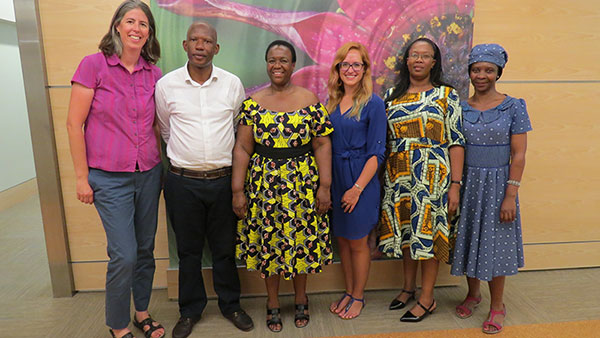Spotlight on Implementing Agencies: Lesotho

From left to right: Joanna Lowell of The DHS Program, Mr. Leutsoa Matsoso and Motsoanku Grace ‘Mefane of the Ministry of Health, Michelle Surdyk of USAID, Anna Masheane-Moseneke and Mahlape Ramoseme of the Ministry of Health
Name(s): Mrs. Anna Malefa Masheane/Moseneke (HIV/TB Clinical Officer), Miss Motsoanku Grace ‘Mefane (Sexual and Reproductive Health Manager), Miss Mahlape Ramoseme (Chief Statistician), and Mr. Leutsoa Matsoso (Head M&E Officer) of the Ministry of Health.
Country of origin: Lesotho
When not working, favorite place to visit:
Anna: At the stadium watching football.
Motsoanku Grace: Public places to meet people, like hotels and parks, usually in the afternoon.
What has been the nicest surprise visiting The DHS Program headquarters?
Anna: Everybody seem to be busy doing their work.
Motsoanku Grace: The lack of noise.
Mahlape: Your team spirit towards your visitors.
What do you miss most about home when you are here?
Anna: Family members.
Motsoanku Grace: Braai and Papa.
Mahlape: Friends.
Leutsoa: Colleagues.
What is the biggest difference between The DHS Program headquarters office and your office at home?
Anna: Security here is very tight.
Motsoanku Grace: Staff here can work from home while in Lesotho we are always expected to come on duty for work.
What is your favorite DHS final report cover?
 All: The 2009 Lesotho DHS.
All: The 2009 Lesotho DHS.
Favorite DHS chapter or indicator?
Anna: Maternal Health.
Motsoanku Grace: Child Health.
Mahlape: HIV/AIDS.
What population or health issue are you most passionate about?
Anna: Children under five.
Motsoanku Grace: Women of childbearing age.
How do you hope the DHS data from your country will be used?
Anna: For advocating for support from partners.
Motsoanku Grace: Prioritizing funding.
Mahlape: Decision making.
What have you learned from the DHS experience?
Anna: I find it easy to read and understand the tables now.
Motsoanku Grace: How to interpret surveys and write what results from them.
The 2014 Lesotho DHS was released on June 15, 2016. Download the final report here: http://bit.ly/LDHS14

